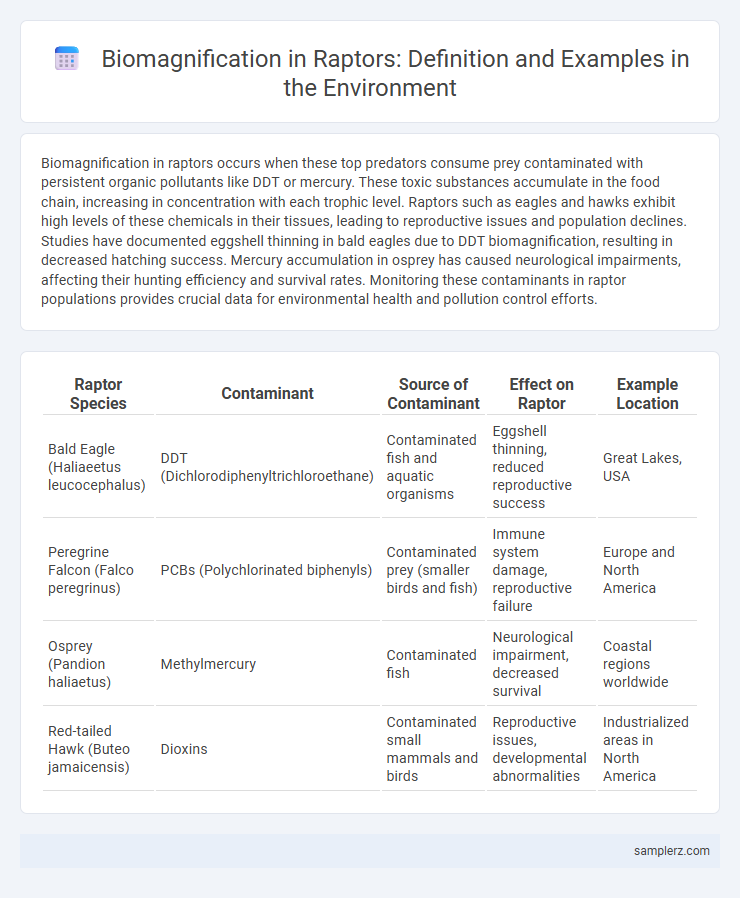Biomagnification in raptors occurs when these top predators consume prey contaminated with persistent organic pollutants like DDT or mercury. These toxic substances accumulate in the food chain, increasing in concentration with each trophic level. Raptors such as eagles and hawks exhibit high levels of these chemicals in their tissues, leading to reproductive issues and population declines. Studies have documented eggshell thinning in bald eagles due to DDT biomagnification, resulting in decreased hatching success. Mercury accumulation in osprey has caused neurological impairments, affecting their hunting efficiency and survival rates. Monitoring these contaminants in raptor populations provides crucial data for environmental health and pollution control efforts.
Table of Comparison
| Raptor Species | Contaminant | Source of Contaminant | Effect on Raptor | Example Location |
|---|---|---|---|---|
| Bald Eagle (Haliaeetus leucocephalus) | DDT (Dichlorodiphenyltrichloroethane) | Contaminated fish and aquatic organisms | Eggshell thinning, reduced reproductive success | Great Lakes, USA |
| Peregrine Falcon (Falco peregrinus) | PCBs (Polychlorinated biphenyls) | Contaminated prey (smaller birds and fish) | Immune system damage, reproductive failure | Europe and North America |
| Osprey (Pandion haliaetus) | Methylmercury | Contaminated fish | Neurological impairment, decreased survival | Coastal regions worldwide |
| Red-tailed Hawk (Buteo jamaicensis) | Dioxins | Contaminated small mammals and birds | Reproductive issues, developmental abnormalities | Industrialized areas in North America |
Understanding Biomagnification: A Threat to Raptors
Raptors, such as eagles and hawks, accumulate toxic substances like DDT and mercury through the food chain, illustrating biomagnification's deadly impact. These pollutants concentrate in their bodies as they consume contaminated prey, leading to reproductive failure and population decline. Monitoring these apex predators helps scientists track ecosystem health and the persistence of hazardous chemicals in the environment.
How Biomagnification Occurs in Raptor Food Chains
Biomagnification occurs in raptor food chains as toxic substances like mercury and DDT accumulate in prey species and increase in concentration at each trophic level. Raptors, being apex predators, consume multiple contaminated organisms, resulting in higher pollutant levels in their tissues. This concentration leads to reproductive issues and population declines in species such as bald eagles and ospreys.
Case Study: DDT Biomagnification in Bald Eagles
Biomagnification of DDT in bald eagles led to eggshell thinning and significant population declines during the mid-20th century. As a top predator, bald eagles accumulated high concentrations of DDT through the food chain, impacting their reproductive success. Landmark studies linking DDT exposure to eggshell fragility prompted regulatory bans and subsequent recovery of bald eagle populations.
Mercury Accumulation in Osprey Populations
Mercury accumulation in osprey populations exemplifies biomagnification, where mercury concentrations increase at each trophic level through contaminated aquatic food chains. Ospreys consume fish containing methylmercury, leading to higher mercury levels in their tissues compared to lower trophic organisms. This bioaccumulation causes neurotoxic effects and reproductive impairments, threatening osprey survival and ecosystem health.
The Impact of PCBs on Peregrine Falcons
Polychlorinated biphenyls (PCBs) accumulate through the food chain, causing biomagnification in peregrine falcons. These raptors ingest prey contaminated with PCBs, resulting in high toxin concentrations that disrupt their reproductive systems and reduce offspring survival rates. Studies reveal that PCB exposure leads to thinner eggshells and impaired immune responses, threatening peregrine falcon populations worldwide.
Biomagnification of Heavy Metals in Hawks
Heavy metals such as mercury and lead accumulate in hawks through the food chain, with concentrations increasing at each trophic level due to biomagnification. These toxins originate from contaminated water, soil, and prey species, leading to neurological damage and reproductive failure in hawk populations. Studies reveal that top predators like hawks exhibit the highest accumulation of heavy metals, significantly impacting their survival and ecosystem health.
Raptors as Top Predators: Why They’re Most at Risk
Raptors, as top predators, experience significant biomagnification because toxic substances like mercury and DDT accumulate in their prey and intensify up the food chain. These contaminants disrupt reproductive systems, reduce egg viability, and cause population declines, exemplified by the historic thinning of eggshells in bald eagles. Their position at the apex of ecosystems makes raptors especially vulnerable to environmental pollutants that persist and magnify through trophic levels.
Ecological Consequences of Biomagnification in Raptors
Raptors such as eagles and hawks accumulate high levels of pesticides like DDT through biomagnification, leading to eggshell thinning and reduced reproductive success. These ecological consequences disrupt predator-prey dynamics and threaten raptor population stability. Persistent organic pollutants in raptors also indicate widespread environmental contamination affecting broader ecosystem health.
Mitigating Biomagnification: Conservation Strategies for Raptors
Raptors such as eagles and hawks experience biomagnification through the accumulation of pesticides like DDT in their prey, leading to reproductive issues and population declines. Conservation strategies focus on monitoring contaminant levels, implementing bans on harmful chemicals, and restoring habitats to support healthier food chains. Efforts also include the use of nest protection programs and public education to reduce human-induced environmental toxins affecting raptor populations.
Monitoring Biomagnification Trends in Raptor Species
Monitoring biomagnification trends in raptor species involves analyzing contaminant levels such as mercury and PCBs in top predators like the bald eagle and peregrine falcon. Data collected through blood and feather samples reveal increasing concentrations of toxins along the food chain, indicating ecosystem health risks. Long-term surveillance aids in detecting changes over time, guiding conservation efforts and pollution mitigation strategies.

example of biomagnification in raptor Infographic
 samplerz.com
samplerz.com